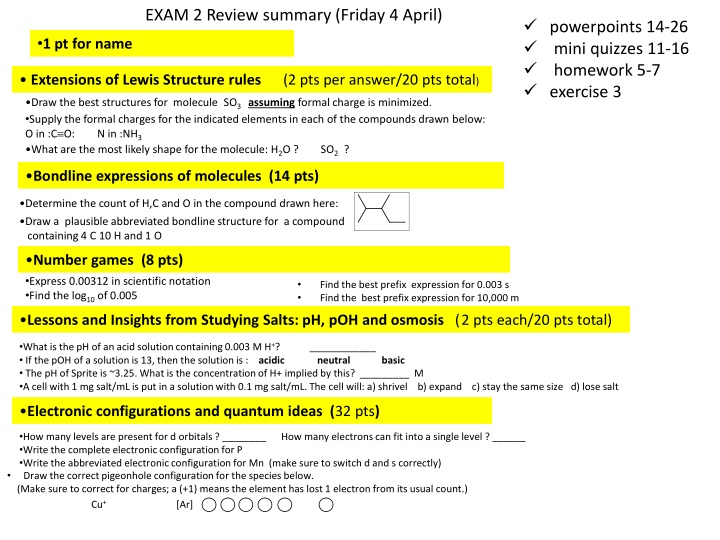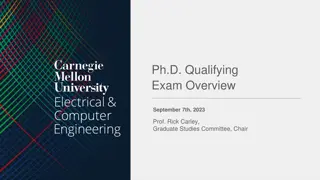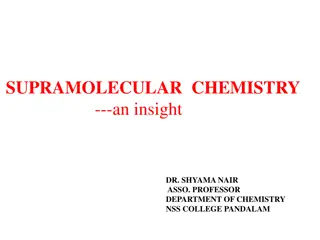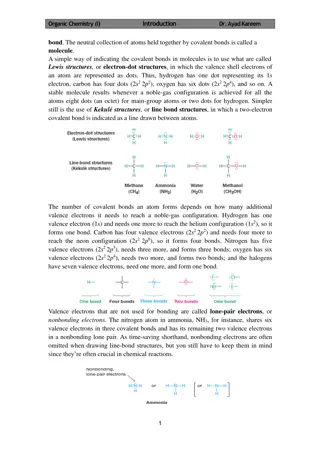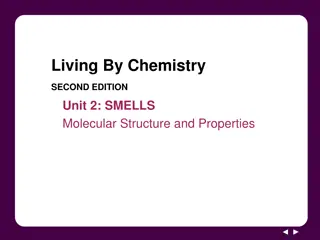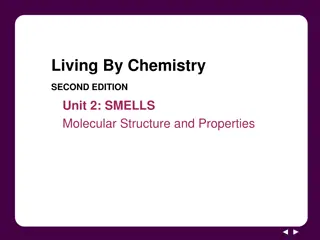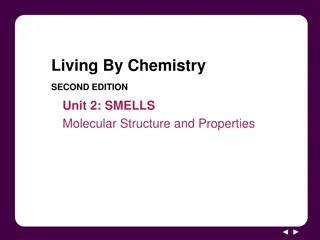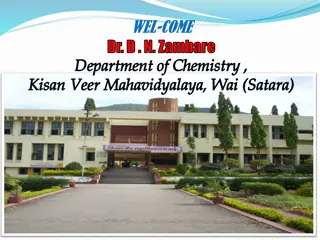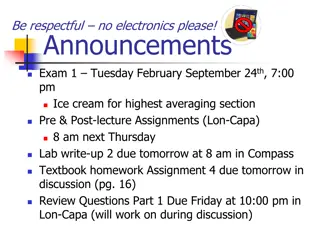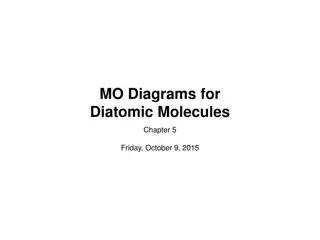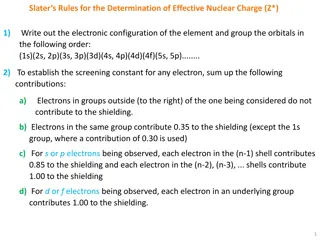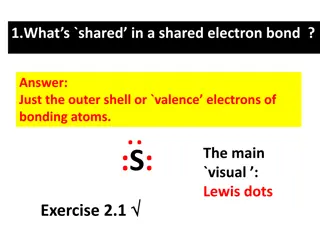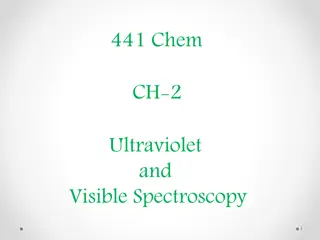Chemistry Exam Review: Lewis Structures, Molecules, Electronic Configurations
Dive into a comprehensive review for your upcoming chemistry exam covering topics such as drawing Lewis structures, determining formal charges, molecule shapes, bondline expressions, pH calculations, electron configurations, and more. Brush up on key concepts like prefixes, scientific notation, and measurements with engaging examples and practical insights. Enhance your understanding and be fully prepared to tackle the exam with confidence.
Download Presentation

Please find below an Image/Link to download the presentation.
The content on the website is provided AS IS for your information and personal use only. It may not be sold, licensed, or shared on other websites without obtaining consent from the author.If you encounter any issues during the download, it is possible that the publisher has removed the file from their server.
You are allowed to download the files provided on this website for personal or commercial use, subject to the condition that they are used lawfully. All files are the property of their respective owners.
The content on the website is provided AS IS for your information and personal use only. It may not be sold, licensed, or shared on other websites without obtaining consent from the author.
E N D
Presentation Transcript
EXAM 2 Review summary (Friday 4 April) powerpoints 14-26 mini quizzes 11-16 homework 5-7 exercise 3 1 pt for name Extensions of Lewis Structure rules (2 pts per answer/20 pts total) Draw the best structures for molecule SO3 assuming formal charge is minimized. Supply the formal charges for the indicated elements in each of the compounds drawn below: O in :C O: N in :NH3 What are the most likely shape for the molecule: H2O ? SO2 ? Bondline expressions of molecules (14 pts) Determine the count of H,C and O in the compound drawn here: Draw a plausible abbreviated bondline structure for a compound containing 4 C 10 H and 1 O Number games (8 pts) Express 0.00312 in scientific notation Find the log10 of 0.005 Find the best prefix expression for 0.003 s Find the best prefix expression for 10,000 m Lessons and Insights from Studying Salts: pH, pOH and osmosis (2 pts each/20 pts total) What is the pH of an acid solution containing 0.003 M H+? If the pOH of a solution is 13, then the solution is : acidic The pH of Sprite is ~3.25. What is the concentration of H+ implied by this? _________ M A cell with 1 mg salt/mL is put in a solution with 0.1 mg salt/mL. The cell will: a) shrivel b) expand c) stay the same size d) lose salt ____________ neutral basic Electronic configurations and quantum ideas (32 pts) How many levels are present for d orbitals ? ________ How many electrons can fit into a single level ? ______ Write the complete electronic configuration for P Write the abbreviated electronic configuration for Mn (make sure to switch d and s correctly) Draw the correct pigeonhole configuration for the species below. (Make sure to correct for charges; a (+1) means the element has lost 1 electron from its usual count.) Cu+ [Ar]
A necessary prequel part 3 : numbers, units, prefixes RANDOM FACTOIDS Width of a human blood cell ~0.000002 m time for computer to do a single operation ~ 0.000000003 s Average M-1 battle tank weighs ~ 18,200,000 g Distance to Sun=12,874,800,000 m Using a single metric measure is often inconvenient .object studied is either too Or too small
A necessary prequel : numbers, units, prefixes (continued) Using prefixes to simplify metric measure (see also text pp 21-22 and Table 1.1. page 19) magnitude = prefix =symbol 10+9 10+6 10+3 10-1 10-3 10-6 10-9 10-12 giga- mega- kilo- deci- milli- m micro- nano- pico- G M k d n p Width of human blood cell ~0.000002 m EXAMPLE #1 2.0 * m 1)Convert to scientific notation 2.0 *10-6 m 2) Find the exponent term in the prefix table 3) Replace the exponent term in your measure with the exponent s symbol
magnitude = prefix =symbol 10+9 10+6 10+3 10-1 deci- 10-2 10-3 milli- 10-6 micro- 10-9 nano- 10-12 pico- EXAMPLE #2 giga G M k mega- kilo- d centi- c m n p time for computer to do a single operation ~ 0.000000003 s 1)Convert to scientific notation 3.0 *10-9 s 2) Find the exponent term in the prefix table 3.0 *ns 3) Replace the exponent term in your measure with the exponent s symbol
A necessary prequel : numbers, units, prefixes (continued) LISTEN UP, MAGGOTS PREFIXES you are responsible for remembering metric PREFIXES, symbols and numeric equivalents on the next page
A necessary prequel : numbers, units, prefixes (continued) KNOW THESE MAGGOTS . magnitude = prefix = symbol 10+9 10+6 mega- 10+3 kilo- k 10-1 10-2 centi- 10-3 milli- m 10-6 10-9 10-12 G giga- M deci- d c micro- nano- n pico- p
More prefix assignments. with a twist: examples 3 and 4 Done on board Average M-1 battle tank weighs ~ 18,200,000 g 1.82*107 g= 18.2 Mg Distance to Sun=12,874,800,000 m 1.2874*1010 m = 12.874 Gm 10+9 giga 10+6 mega- 10+3 kilo- 10-1 deci- 10-2 centi- 10-3 milli- 10-6 micro- 10-9 nano- 10-12 pico- G M k d c m n p
Average Japanese sumo wrestler weighs ~ 180,000 g. (~ 400 lbs) Express this little fella s mass with correct prefix =180 kg 10+9 10+6 10+3 10-1 deci- 10-2 10-3 milli- 10-6 micro- 10-9 nano- 10-12 pico- giga G M k mega- kilo- I ate a breakfast sushi roll thisbig today . d centi- c m n p
In-class practice picking prefixes magnitude = prefix = symbol 10+9 10+6 mega- 10+3 kilo- k 10-1 10-2 centi- 10-3 milli- m 10-6 10-9 10-12 G giga- M deci- d c micro- nano- n pico- p
INTRO TO MOLES: Every science involves counting. Astronomers count Animal biologists count . Bacteriologists count .. Chemists count .
How chemists count atoms and molecules: the mole concept See also: text pp 61-63 Doc s `dumb question #1 How long would it take the fastest (single chip) computer in the world (The Fujitsu `Venus ) to count all the molecules of water in a teacup assuming it counted at its maximum processor rate = 128,000,000,000 molecules/second (128 GHz) ? Answer: ~ 2 million years How do we `count atoms and molecules without having to actually count them ???
A seemingly silly digression : egg math exercise #1a dumb Doc questions: 12eggs/dozen A) A dozen large eggs is how many eggs? B)Mass of 1 dozen large eggs = 700 g/dozen* 1) What do 5 dozen large eggs weigh? 5 dozen * 700 g = 3500 g dozen 1 (one) dozen large eggs * According to Danny Wegman s site
More dumb Doc questions: egg math exercise #1b 12 A) 1 dozen eggs = B)Mass of 1 dozen large eggs = 700 g/dozen 2) How many dozens in 2800 g of large eggs ? 2,800 g * 1 dozen =4 dozen 700 g
More dumb Doc questions: egg math exercise #1c 12 A) 1 dozen eggs = B)Mass of 1 dozen large eggs = 700 g/dozen 3) How many eggs in 14,000 g of large eggs ? 14,000 g * 1 dozen * 12 eggs dozen 700 g * 12 eggs dozen 20 dozen =240 large eggs
A seemingly silly digression : egg math exercise #2 And Yet More dumb Doc questions: A) A dozen small eggs is how many eggs? 12 eggs/dozen B)Mass of 1 dozen small eggs = 400 g/dozen* 2a) What do 5 dozen small eggs weigh? 5 dozen * 400 g = 2000 g Small vs large eggs dozen * According to Danny Wegman s site
More dumb Doc questions: egg math exercise #2b 12 A) 1 dozen eggs = B)Mass of 1 dozen small eggs = 400 g/dozen 2) How many dozens in 2800 g of small eggs ? 2,800 g * 1 dozen =7 dozen 400 g
More dumb Doc questions: egg math exercise #2c 12 A) 1 dozen eggs = B)Mass of 1 dozen small eggs = 400 g/dozen 3) How many eggs in 14,000 g of small eggs ? 14,000 g * 1 dozen * 12 eggs dozen 400 g * 12 eggs dozen 35 dozen =420 small eggs
ASSERTION: EGG MATH AND MOLE MATH ARE THE SAME EGG WORLD CHEMISTRY WORLD quantity Smallest unit 1 egg 1 molecule Practical Counting unit Dozen Chemist s dozen = mole Count in practical counting unit 6.0221 *1023 (Avogodro s #) 12 =grams/mole =gram molecular weight = MW (molecular weight) Practical mass unit grams/dozen
Egg vs mole calculations A)Mass of 1 dozen large eggs = 700 g/dozen 1) What do 5 dozen large eggs weigh ? A)Mass of 1 chemist s dozen H2O (1 mole)= 18 g/mole 1) What do 5 moles of water weigh ? 5 dozen * 700 g 5 moles * 18 g dozen mole = 3500 grams =90 grams
Egg vs mole calculations A)Mass of 1 dozen large eggs = A)Mass of 1 chemist s dozen H2O (1 mole)= 18 g/mole 700 g/dozen 2) How many dozens in 2800 g of large eggs ? 2) How many moles in 2800 g of H2O ? 2800 g* 1 dozen 700 g 2800 g * 1 mole 18 g =155.55 moles = 4 dozen
Egg vs mole calculations A)Mass of 1 dozen large eggs = 700 g/dozen A)Mass of 1 chemist s dozen H2O (1 mole)= 18 g/mole B) 1 dozen = 12 6.0221*1023 B) 1 mole = 3) How many large eggs in 14,000 grams of eggs ? 3) How many H2O molecules in 14,000 grams of H2O ? *6.022*1023 mole H2O 14,0000 g * 1 mole 18 g 14,000 g* 1 dozen 700 g *12 eggs dozen *6.022*1023 mole H2O 777.77 mole H2O *12 eggs dozen 20 dozen =240 eggs 4.68*1026 molecules of H2O
